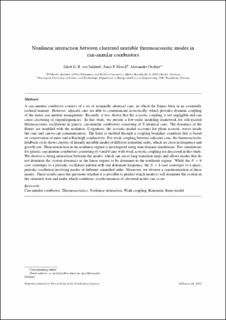| dc.contributor.author | von Saldern, Jakob | |
| dc.contributor.author | Moeck, Jonas | |
| dc.contributor.author | Orchini, Alessandro | |
| dc.date.accessioned | 2021-03-24T08:53:11Z | |
| dc.date.available | 2021-03-24T08:53:11Z | |
| dc.date.created | 2020-10-05T14:00:47Z | |
| dc.date.issued | 2020 | |
| dc.identifier.citation | Proceedings of the Combustion Institute. 2020, . | en_US |
| dc.identifier.issn | 1540-7489 | |
| dc.identifier.uri | https://hdl.handle.net/11250/2735213 | |
| dc.description.abstract | A can-annular combustor consists of a set of nominally identical cans, in which the flames burn in an essentially isolated manner. However, adjacent cans are able to communicate acoustically, which provides dynamic coupling of the entire can-annular arrangement. Recently, it was shown that the acoustic coupling is not negligible and can cause clustering of eigenfrequencies. In this study, we present a low-order modeling framework for self-excited thermoacoustic oscillations in generic can-annular combustors consisting of N identical cans. The dynamics of the flames are modeled with the nonlinear G-equation; the acoustic model accounts for plane acoustic waves inside the cans and can-to-can communication. The latter is enabled through a coupling boundary condition that is based on conservation of mass and a Rayleigh conductivity. For weak coupling between adjacent cans, the thermoacoustic feedback cycle shows clusters of linearly unstable modes of different azimuthal order, which are close in frequency and growth rate. Their interaction in the nonlinear regime is investigated using time-domain simulations. Two simulations for generic can-annular combustors consisting of 4 and 6 cans with weak acoustic coupling are discussed in this study. We observe a strong interaction between the modes, which can cause long transition times and allows modes that do not dominate the system dynamics in the linear regime to be dominant in the nonlinear regime. While the case converges to a periodic oscillation pattern with one dominant frequency, the case converges to a quasi-periodic oscillation involving modes of different azimuthal order. Moreover, we observe a synchronization of these modes. These results raise the questions whether it is possible to predict which mode(s) will dominate the system in the saturated state and under which conditions synchronization of clustered modes can occur. | en_US |
| dc.language.iso | eng | en_US |
| dc.publisher | Elsevier | en_US |
| dc.rights | Attribution-NonCommercial-NoDerivatives 4.0 Internasjonal | * |
| dc.rights.uri | http://creativecommons.org/licenses/by-nc-nd/4.0/deed.no | * |
| dc.title | Nonlinear interaction between clustered unstable thermoacoustic modes in can-annular combustors | en_US |
| dc.type | Peer reviewed | en_US |
| dc.type | Journal article | en_US |
| dc.description.version | acceptedVersion | en_US |
| dc.source.pagenumber | 9 | en_US |
| dc.source.journal | Proceedings of the Combustion Institute | en_US |
| dc.identifier.doi | 10.1016/j.proci.2020.06.236 | |
| dc.identifier.cristin | 1837114 | |
| dc.description.localcode | "© 2020. This is the authors’ accepted and refereed manuscript to the article. Locked until 16.9.2022 due to copyright restrictions. This manuscript version is made available under the CC-BY-NC-ND 4.0 license http://creativecommons.org/licenses/by-nc-nd/4.0/ " | en_US |
| cristin.ispublished | true | |
| cristin.fulltext | postprint | |
| cristin.qualitycode | 2 | |

